Discovering Korea and Japan through Cornell’s MBA Winter Trek
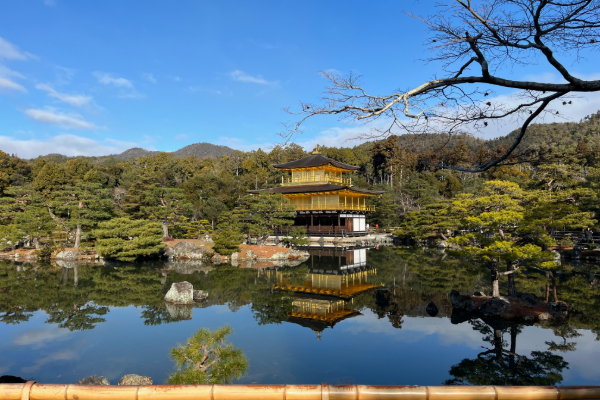
Kinkaku-ji, also called the Golden Pavilion, is a historic temple in Kyoto; its top two floors are covered in gold leaf. (Photo by Shreya Kumar)
Being part of the Samuel Curtis Johnson Graduate School of Management winter trek to Korea and Japan was the experience of a lifetime. The trek has been a beloved tradition within the Johnson MBA community, where students travel together for 18 days over winter break, experiencing five cities across two countries.
For many years, the trek has been led by Mark Milstein, clinical professor of management and academic director of the Center for Sustainable Global Enterprise. This year, he was joined by Monica Touesnard, executive director of the Center for Sustainable Global Enterprise, and Nicole Pellegrino, executive director of MBA programs. For 38 second-year MBA students, this trek provided a transformative experience, blending business education, networking, and cultural immersion.
For me, this trip was an invaluable opportunity to experience Korean and Japanese culture while gaining insights into a diverse range of businesses. We visited 11 companies across financial services, venture capital, manufacturing, and consumer packaged goods. Some of the most memorable visits included Red Bull, Kewpie, and Kundal, where we explored how global business strategies adapt to regional markets, cultural differences, and sustainability initiatives.
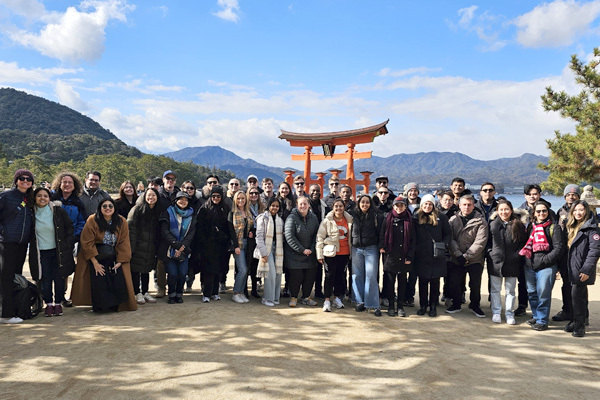
Exploring Seoul, South Korea: A modern metropolis with deep cultural roots
Our journey began in Seoul, South Korea, a city that seamlessly blends cutting-edge technology, historic landmarks, and a thriving startup ecosystem. Our first company visit was to Kundal, one of South Korea’s fastest-growing beauty and personal care brands, where we gained insights into the global rise of K-beauty. Later, we met with LB Investments, a venture capital firm, to discuss South Korea’s evolving startup landscape and investment trends. Our visit to CJ Group, one of South Korea’s largest conglomerates, offered a fascinating look into the complexities of running a diversified business spanning entertainment, food, and logistics.
We also explored cultural landmarks such as the Blue House, South Korea’s former presidential residence, and indulged in a traditional Korean spa experience. One of my favorite moments was dressing in hanbok—traditional Korean attire—and wandering the beautiful Gyeongbokgung Palace.
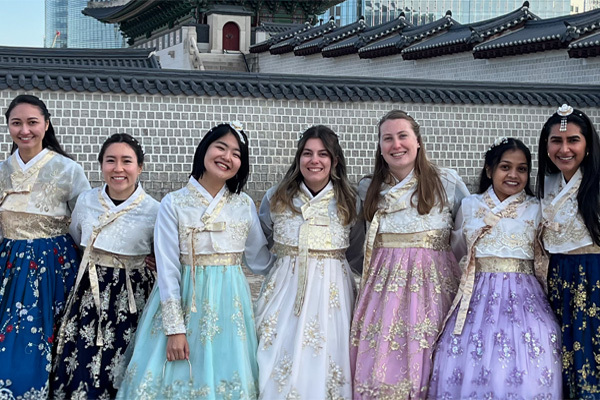
Nestled in the heart of Seoul, the palace felt like an oasis of serenity amidst the bustling city. Wearing the vibrant, ornate hanbok made our time there even more immersive as we learned about the history of Korea’s royal dynasties.
Beppu: Hot springs and meticulous meals
From Seoul, we traveled to Beppu, Japan, a city famous for its natural hot springs (onsen) and geothermal activity. We stayed at a ryokan, a traditional inn. Ryokans feature tatami-matted rooms, where guests sleep on futon mattresses, and yukata robes are provided for lounging. Many ryokans also have onsen baths on-site.
One of my personal highlights from the ryokan was our first kaiseki dinner, a traditional multi-course Japanese meal. Kaiseki cuisine is known for its meticulous presentation, emphasis on seasonal ingredients, and artful cooking techniques. Each dish—from sashimi to simmered delicacies—was a perfect balance of flavor and aesthetics.
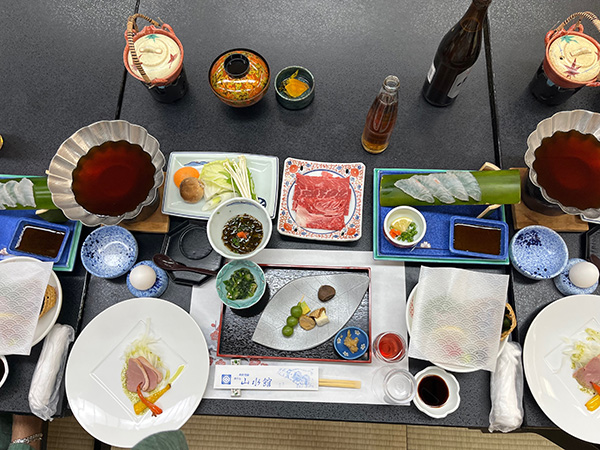
Hiroshima: A city of reflection and resilience
Hiroshima was one of the most moving stops of our journey. We visited the Hiroshima Peace Memorial Park and Memorial Hall for the Atomic Bomb Victims, reflecting on the city’s tragic past and its remarkable transformation into a symbol of peace and resilience.
Later, we visited Miyajima Island, home to a torii gate that appears to float on the water. The island’s scenic beauty and spiritual significance made for an unforgettable day, blending history, nature, and tradition.
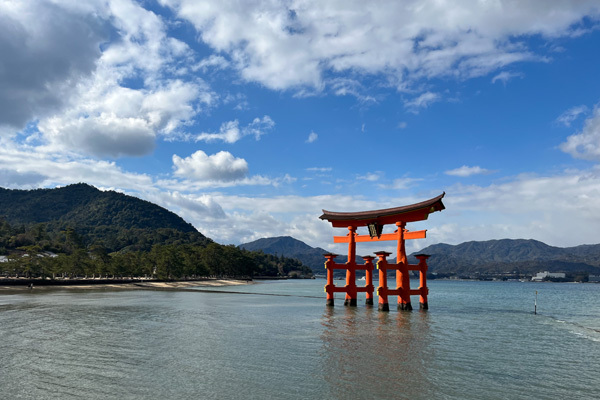
Kyoto: Where tradition meets modernity
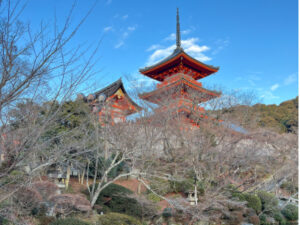
Next, we traveled to Kyoto, Japan’s ancient capital. We explored Kinkaku-ji (the Golden Pavilion), Nijō Castle, Arashiyama Bamboo Forest, and Kiyomizu-dera Temple, a monastery overlooking the city.
One of my favorite moments was strolling through Kyoto’s old city and visiting its pottery shops, artisan boutiques, and specialty stores. Our group dinner in Kyoto was another highlight, where we indulged in local cuisine while reflecting on our journey so far. Kyoto’s traditions and its exquisite food scene made it one of my favorite cities on the trek.
Tokyo: Japan’s economic and cultural capital
Our final stop was Tokyo, and the contrast between Kyoto’s tranquil temples and Tokyo’s high-energy business districts was striking.
One of my most memorable cultural experiences in Tokyo was attending a live sumo match, offering a rare and authentic glimpse into Japan’s national sport. We also made several company visits, where executives emphasized the importance of understanding Japanese consumers and the role that cultural nuance plays in success in the region. A standout visit was Red Bull, where we explored the company’s marketing strategies aimed at expanding market share in Japan. Our group found it fascinating to see how a global brand adapted its approach to resonate with Japan’s consumer landscape.
While in Tokyo, our group connected with the local Cornell community. Our expatriate and Japanese alumni are dedicated to Big Red, even 6,700 miles away! Alumni shared their insights on Japanese business culture and the career journeys that brought them to live and work in Tokyo.
We concluded our trek with a farewell dinner cruise in Tokyo Bay.
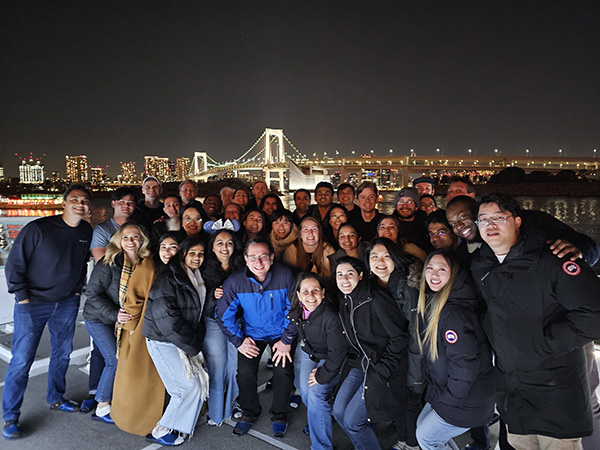
Final reflections: Lessons from Korea and Japan
As we boarded our flights back to Ithaca for our final semester, I felt immensely grateful for the friendships, experiences, and lessons gained on this trek. My key takeaway from this experience is that cultural immersion truly matters. This trip blended education in history, customs, and traditions as well as expanded our MBA expertise in global business strategy. Our understanding of each business we visited was deepened by experience with the local culture.
This trek was more than a study trip—it was a transformative journey that broadened my worldview, challenged my assumptions, and created lifelong memories with an incredible group of peers.
About the author

Shreya Kumar MBA ’25 is an Emerging Markets Institute Fellow in the Two-Year MBA program in the Samuel Curtis Johnson Graduate School of Management. Kumar has over a decade of experience in sales, marketing, and customer relationship management at companies including Google and WeWork. She plans to continue her career in sales and partnerships after graduation in May. Kumar is passionate about wine and was co-president of the Cornell Johnson Wine and Spirits Club. A dog lover, she enjoys hiking with her 3-year-old goldendoodle, Luna.
